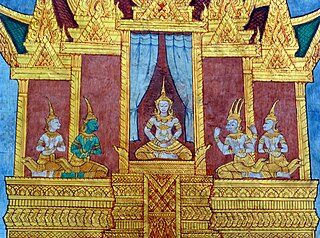Nimi may refer to
- Nimi (king), a king of the Solar dynasty in Hindu mythology
- Nimi language, spoken in Papua New Guinea
- Niimi, Okayama, Japan
- Non-Instrumental Movement Inhibition, an aspect of body language
Nimi may refer to

Ladonia is a micronation, proclaimed in 1996 as the result of a years-long court battle between artist Lars Vilks and local authorities over two sculptures. The claimed territory is part of the natural reserve of Kullaberg in southern Sweden.

Janaka was an ancient Hindu king of Videha which was located in Mithila region, approximately in the 8th or 7th century BC. The rulers of the Videha kingdom were called Janakas. He also appears in epic Ramayana as a father of Sita. His original name was Seeradhwaja and he had a brother named Kushadhwaja. His father's name was Hrasvaroman, a descendant of the king Nimi.
Ikshvaku is a legendary king in Hindu mythology. He is described to be the first king of the Kosala kingdom, and was one of the ten sons of Shraddhadeva Manu, the first man on the earth. He was the founder and first king of the Ikshvaku dynasty, also known as the Suryavamsha, in the kingdom of Kosala, which also historically existed in ancient India. He had a hundred sons, among whom the eldest was Vikukshi. Another son of Ikshvaku's, named Nimi, founded the Kingdom of the Videhas. Rama, Mahavira, and the Buddha are also stated to have belonged to the Suryavamsha or Ikshvaku dynasty.

The Kingdom of Kongo was a kingdom in Central Africa. It was located in present-day northern Angola, the western portion of the Democratic Republic of the Congo, and the Republic of the Congo. At its greatest extent it reached from the Atlantic Ocean in the west to the Kwango River in the east, and from the Congo River in the north to the Kwanza River in the south. The kingdom consisted of several core provinces ruled by the Manikongo, the Portuguese version of the Kongo title Mwene Kongo, meaning "lord or ruler of the Kongo kingdom", but its sphere of influence extended to neighboring kingdoms, such as Ngoyo, Kakongo, Loango, Ndongo, and Matamba, the latter two located in what is Angola today.
Polish Sign Language is the language of the deaf community in Poland. Polish Sign Language uses a distinctive one-handed manual alphabet based on the alphabet used in Old French Sign Language and therefore appears to be related to French Sign Language. It may also have common features with Russian Sign Language and German Sign Language, which is related to the history of Poland during the Partitions, when Russification and Germanization significantly influenced the Polish language, and may also have borrowings from the sign language used in the Austrian partition. Its lexicon and grammar are distinct from the Polish language, although there is a manually coded version of Polish known as System Językowo-Migowy, which is often used by interpreters on television and by teachers in schools.

Lukeni lua Nimi was the traditional founder of the Lukeni kanda dynasty, first king of Kongo and founder of the Kingdom of Kongo Dia Ntotila. The name Nimi a Lukeni appeared in later oral traditions and some modern historians, notably Jean Cuvelier, popularized it. He conquered the kingdom of Mwene.

Toki Pona ; ) is a philosophical artistic constructed language known for its small vocabulary, simplicity, and ease of acquisition. It was created by Sonja Lang, a Canadian linguist and translator, to simplify thoughts and communication. The first drafts were published online in 2001, while the complete form was published in the book Toki Pona: The Language of Good in 2014. Lang also released a supplementary dictionary, the Toki Pona Dictionary, in July 2021, based on community usage.
Nlaza of Kongo was a manikongo from the Lukeni kanda dynasty and the 3rd ruler of the Central African kingdom of Kongo in the early 15th century. Little is known about him or his reign other than he was one of two cousins of Kongo's founder, Lukeni lua Nimi.

Álvaro III Nimi a Mpanzu, also known as Álvaro III Mbiki a Mpanzu, ruled as king or manikongo of the Kingdom of Kongo from August 1615 to 4 May 1622. Prior to becoming king, he had served as Duke of Mbamba. Like his predecessor, Bernardo II he was a son of King Álvaro II. King Álvaro III was the fourth ruler from the royal house of Kwilu established by King Álvaro I. In 1622, Álvaro III died while his son, Ambrósio, was too young to become king. The nobles elected the Duke of Mbamba to the post of mwenekongo, ushering the short dynasty of the House of Nsundi.

South Estonian is either a Finnic language or an Estonian dialect, spoken in south-eastern Estonia, encompassing the Tartu, Mulgi, Võro and Seto varieties. There is no academic consensus on its status as a dialect or language. Diachronically speaking, North and South Estonian are separate branches of the Finnic languages.

Álvaro VI of Kongo, sometimes called Nimi a Lukeni a Nzenze a Ntumba, was a ruler of the Kingdom of Kongo.

Nimi is a king of the Suryavamsha featured in Hindu mythology. He is considered to be the first king of the Videha kingdom and is regarded to be the ancestor to the Janaka lineage of Mithila. Nimi is the grandson of Manu, and a son of Ikshvaku.
Neme may refer to:
Otto Maja is a Finnish street artist living and working in Helsinki. He is known for translating the visual language cultivated on the streets into illustrations, paintings and drawings. His works have been exhibited in several locations around Finland, most recently in Pori Art Museum together with such internationally renowned street artists as Blu and Invader.

The Kilukeni were members of the Lukeni kanda or House of Kilukeni, the ruling dynasty of the Kingdom of Kongo from its inception in the late 14th century until the 1567 with the rise of the House of Kwilu. The Kilukeni were springboard for most of the major factions that battled for control of Kongo during its civil war.

Life According to Agfa is a 1993 Israeli psychological-social drama film written and directed by Assi Dayan and produced by Rafi Bukai and Yoram Kislev. Starring Gila Almagor, Shmil Ben Ari, Irit Frank, Shuli Rand, Sharon Alexander and Avital Dicker, the film revolves around one night in a small Tel Aviv pub whose employees and patrons represent a microcosm of Israeli society – men and women, Jews and Arabs, Ashkenazi and Sephardi Jews, kibbutzniks and city-dwellers.
Nimi is a language spoken in Papua New Guinea. There were about 1400 native speakers as of 1980.
The Mahānipāta Jātaka, sometimes translated as the Ten Great Birth Stories of the Buddha, are a set of stories from the Jātaka tales describing the ten final lives of the Bodisattva who would finally be born as Siddhartha Gautama and eventually become Gautama Buddha. These jātaka tales revolve around Benares, the current Varanasi in India. The final ten are the best known of the total 547 jātaka tales. In Cambodia and Thailand, they are known as ទសជាតក and ทศชาติชาดก, respectively. These render the 10 virtues of mankind, that the enlightenment would reveal. These respective virtues are: renunciation, vigour, benevolence, absolute determination, insight, morality, patience, equanimity, reality and generosity.
Non-Instrumental Movement Inhibition (NIMI) is an aspect of body language when a person stops fidgeting because they are interested in what they are watching. For example, when a young child is rapt watching a cartoon, they often sit motionless with their mouth open; this motionlessness is NIMI. As such, it is psychological phenomenon and a form of embodied behavior, where gestures and body movements reflect the thoughts and emotions in a person's mind. This phenomenon is different from almost all other body language because it interprets what does not happen rather than making an interpretation based on a specific gesture. During NIMI, visual engagement or attention leads subconsciously to lower levels of fidgeting .